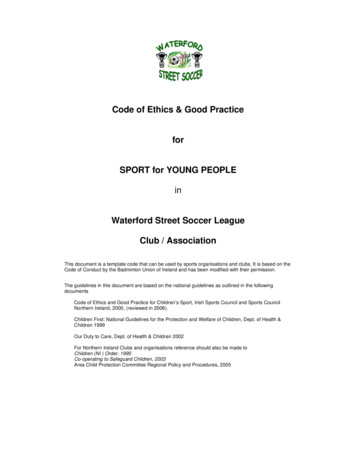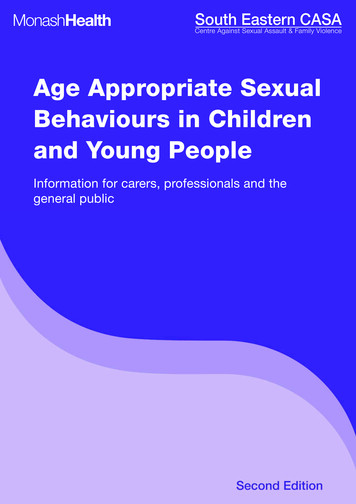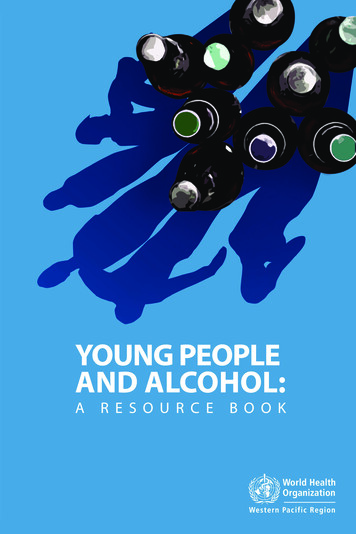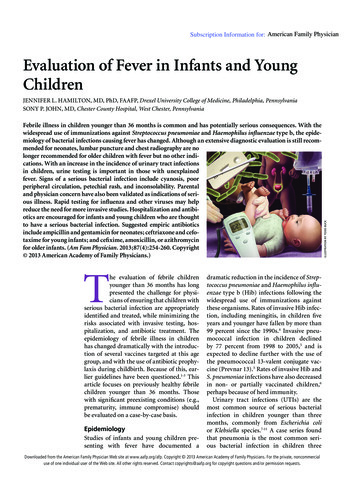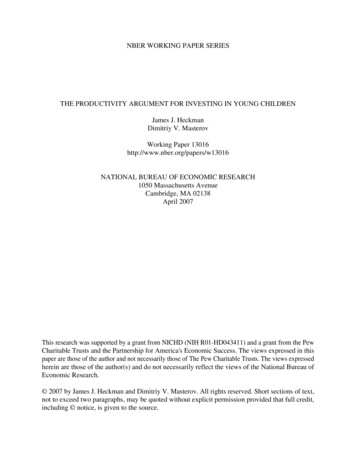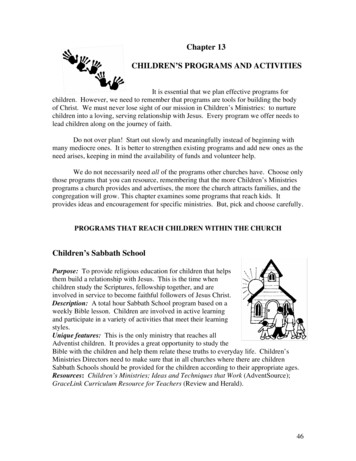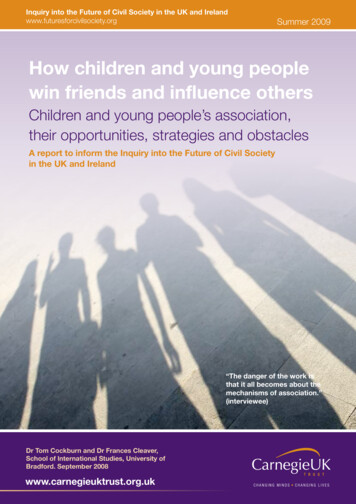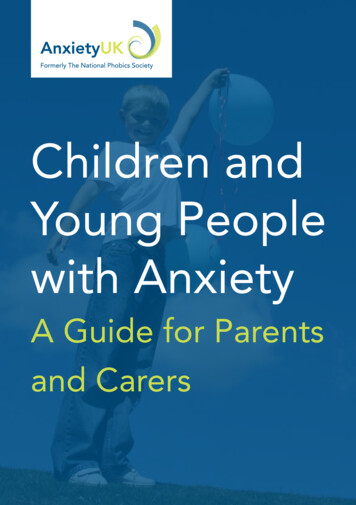
Transcription
Children andYoung Peoplewith AnxietyA Guide for Parentsand Carers1
ContentsIntroduction4What is anxiety?5How anxiety is maintained6Common anxiety disorders in young people 8Self help techniques for parents14Anxiety in school18Sources of help and support22Treatments available28Support for parents32At Anxiety UK, we understand the concerns that many parents have regarding theirchildren’s well-being. Every year we receive hundreds of calls to our helpline fromparents, teachers, support workers and young people themselves who have questionsabout how to access professional help, how families can provide appropriate supportand understanding along with information about how to liaise with schools and otherhealth professionals. We would like to thank all the parents who contacted us andprovided valuable information for the content of this booklet. Indeed, we hope thisbooklet, and the accompanying DVD will be a useful resource to parents, carers andyoung people with anxiety problems. If you would like information regarding further workAnxiety UK is doing to promote services for young people then please visit our websitewww.anxietyuk.org.uk or call 08444 775 774.23
IntroductionWhat is anxiety?Anxiety has been found to be one of the most common causes of distress in childrenand young people. As many as one in five primary school children suffer from a lowsense of wellbeing according to a recent report by Morrison-Gutman et al (2008) onchildren’s well being in schools. This equates to around six children in the averageschool class. Research from the Institute of Education in London found that girlswere more likely to suffer poor mental health than boys, and that boys who struggledacademically were most likely to have negative views of themselves and experiencedepression.Anxiety can affect us all in very different ways. Experiences of anxiety can vary greatlyfrom person to person and no two people have precisely the same experience.Anxiety is a completely normal emotion - we all experience it from time to time (thinkback to your driving test, or an exam for example). However, when a person issuffering with an anxiety disorder, the feeling of anxiety is far more intense and longlasting. When in the middle of an anxiety attack it can feel as if you are going to gomad, pass out or have a heart attack. If your child experiences severe anxiety, they canget exactly the same feelings and symptoms as adults. They may look terrible whenanxious: pale, clammy, crying, shaking, saying they are going to be sick or pass out.However, when this happens, although they may look ill, they are OK. It is extremelyrare for someone to pass out when anxious, as it increases their blood pressure. Infact, the immune system actually experiences a boost after a short anxiety attack.Remembering this and trying to stay calm will help you stay in control of the situation,and help you to manage your child’s anxiety. One important point to keep in mind isthat not all anxious children and young people will display the characteristics describedabove. Some hide their anxiety for fear of someone finding out that they are anxious,with others showing no signs of anxiousness at all containing their feelings of anxietyinside.Young people’s mental health Some statistics One in six 16- 24 year olds have suffered from an anxiety disorder. Inan average school class, 5 pupils will have experienced anxiety. 2% of 16 – 24 year olds have suffered from a depressive episode. Thisequates to one person in an average school class. 1-2% of 16- 24 year olds have suffered with obsessive compulsivedisorder - see Singleton et al (2001)Anxiety is not only common, but also extremely debilitating. If you are a carer of a childor young person who experiences anxiety you will know the impact an anxiety problemcan have on the whole family’s life. In the next section of this booklet we will look atwhat anxiety is, how it is maintained and some things that you can do to support yourchild.45
How anxiety is maintainedPsychologists believe that anxiety is maintained by a vicious circle of thoughts,behaviours and feelings, such as those described below.Feelings (Physical)E.g. fast heart beat, feeling shaky,feeling like you might faintThoughts (Negative Thinking)The ‘fear of the fear’ often makes people feel worse as they are literally on edgewaiting for bad feelings to happen; they stop doing things that link with the negative(bad) feelings or thoughts. This is called avoidance. The more that someone avoids thething that links with feeling bad, the more they think of it as being dangerous.This means that the next time a person has to face the situation or event, their bodytells them that it is dangerous and the fight, flight or freeze response kicks in (seethe caveman story detailed below). They feel they should either run away from the‘dangerous’ thing, fight it or their body becomes frozen to the spot.Top Tip no. 1 The story of the caveman!This story is useful to help your children understand where anxiety comes fromand it can be adapted depending on the age of the child.Back in the distant past, when we were still cavemen walking around in furs, wecame across many dangers, like dinosaurs and sabre tooth tigers. Our bodies(naturally wanting to protect us from danger) designed a special alarm insideus that was set to go off whenever danger was present. This alarm gave us theability to fight the danger, or run away by increasing our heart rate, and suppliesof blood to our muscles- making us breathe faster. It also made us thinkmore quickly, and be on the alert for dangerous situations. It worked brilliantly!However, as we don’t have dinosaurs or sabre tooth tigers on the planetanymore, we don’t need the special alarm as much. Unfortunately we can’t turnit off, and some peoples’ alarm system gets stuck in ‘on’ mode, which causesthem to feel ready for danger at all times. This is what anxiety is.E.g. I might die, I might have somethingseriously wrong with me, I'm not normal, Ican't cope, I can't manage this feeling, I willonly get worse, other people think I'm strangeFearThe first time either the feelings or the bad thoughts occur,you may feel scared or worried. If you then worry that youwill have the bad thoughts or feelings again, it can lead tothem re-occurring. Eventually, you feel fearful of the feelingsor thoughts happening again.This is known as the "fear of the fear"6Top Tip no. 2 Stop anxiety before it starts!Psychologists have identified a quirk in humans called ‘latent inhibition’. Whatthis means is that if someone has to do something stressful (e.g. go intohospital, go to the dentist), they are less likely to develop a phobia if they havehad a really positive experience of that situation first. So if you know your childhas to do something they may get distressed about, let them have a reallypositive experience in the same situation beforehand (e.g. going to play in thedentist’s chair). It really works!7
Which anxiety disorderscommonly affect youngpeople?As we have seen in the statistics outlined in the introduction, anxiety is an emotionalproblem frequently experienced by young people. Below are some of the mostcommon anxiety disorders that we, Anxiety UK are contacted about by young peopleand their carers. Many young people have symptoms that cover a range of anxieties;boundaries are placed mainly to assist in diagnosis and treatment.Exam Stress / AnxietyExam stress is something that most of us have experienced. It can make us feel tired,under pressure, confused, worried, etc. This is normal and often encourages us to dosome extra revision and work a bit harder! However, too much pressure and anxietycan cause people to feel extremely distressed, resulting in them being unable toconcentrate and worrying about being able to cope, etc.Exam anxiety can also cause you worry during an exam. For example you may feelthat other people are managing the exam better than you or that they will be finding itreally easy whereas you are struggling. This can cause you to feel that your mind has‘gone blank’ and you fail to recall information that you know that you have revised orthat you know well.School PhobiaSchool is not always a place that young people want to spend time in, however forthose with school phobia attending school initiates an extreme panic state that canmake them feel incredibly anxious and distressed. This causes school to be viewed asthe source of their bad feelings, and results in desperate need to avoid the panic again.School phobia can cause problems for families and young people as avoidance ofthe feared situation (i.e. school) can cause truancy, or unauthorised absence fromschool, as well as the young person falling behind in their studies. If this happens, asa parent you can be fined or even imprisoned if your child will not attend school. Inthese circumstances your best option is to find a supportive teacher, or school nurse8who you feel you can trust, and explain the situation. They may be able to advocateon your behalf, or help you implement a phased return to school (with the support of atherapist). They may also be able to arrange for work to be sent home to your child, sothey are less likely to fall behind.Separation AnxietyThis condition is particularly common in younger children, and is a term used todescribe a feeling of anxiety or stress when away from parents/family/guardians, forexample when at school. It is thought to be the commonest disorder found in childrenunder the age of 12. Children tend to worry a lot when their parents/ guardians are notwith them or when they are away from home. This affects how children act towardsother people particularly at school, and they may only feel comfortable at home. Theymay also feel afraid of going to sleep alone and when they do get to sleep, may havenightmares about being apart from their parents / guardian. Quite often children andyoung people with separation anxiety create stories, such as ‘they don’t feel well’ or‘have a tummy ache’ to avoid being away from parents or their home. Sometimes,they worry about what could happen to their parents when they are away, such asthem being in an accident.The fear of new foodsSome children, mainly boys, can only eat a very narrow range of foods, and showextreme anxiety if they are expected to try new foods. The foods that they usually areable to eat are usually beige, dry carbohydrates, such as biscuits, crisps, cereals orbread; dairy products such as milk or yoghurt; and chocolate. This diet does not seemto be harmful to the child, who will grow normally if they are allowed to eat from theiracceptable range of foods.The fear of trying new foods stems from a normal development stage that occurs ataround the age of two years (the neophobic stage). At this age children narrow downthe range of foods accepted and commonly refuse foods that don’t look the sameas foods that they have learned to like. Most children grow out of this stage, and areable to try and accept new foods into their diet. Some children do not move on fromthis stage; whatever the parents try to do. The reluctance to try new foods becomesa fear, and all new foods trigger a disgust response in the child. If the child is forced toeat foods that they cannot accept then they will often vomit, or show a gag (disgust)response. Certain food textures, such as lumpy or slimy food, can be more disgustingthan others.9
Top Tip no. 3 How to cope with food related anxietyNever insist that your child eats food that they do not like.Make sure that your child gets the calories that they need from the foods thatthey do like; whatever those foods might be.Get your child used to being around the food that they fear, just getting used tothe smell and being able to touch ‘disgust foods’ is a start.If you are trying to get your child to taste new foods, don’t do this at mealtimes.Do it at a time when other people aren’t watching and your child is less likely tobe anxious.Start with very small amounts of food; just a taste will do.A food needs to be tasted quite a few times before it is accepted.Make sure that your child’s school is aware of the problem. Your child mayneed to take ‘unhealthy’ foods in their lunch box, or be able to eat at breaktime. Get a letter from a health professional to support this if need be.Selective MutismSelective Mutism (SM) is usually first recognised in people aged between 3 to 8 yearsold. Its symptoms include an inability to speak in certain places such as school or whenchildren have to meet people they don’t know because of feeling so anxious andstressed that they can’t respond. They are usually able to speak normally when theyare at home or in other places where they feel comfortable and safe. As well as findingit hard to talk, young people may also find it hard to make eye contact or feel frozenand unable to move when people are talking to them. They have a tendency to findcertain situations extremely uncomfortable. The following information was volunteeredby a parent of a child with Selective Mutism, who has been involved in a SelectiveMutism organisation for quite some time. She has helped to expand considerably ourunderstanding of this condition, and we thank her for sharing her experience :-High Profile SM sufferersTypically, these predominantly young SM sufferers, present as wholly unable to speakto any adult in a playgroup or school setting. They may or may not be able to talk to afew select children at school (usually out of earshot of supervising adults).These children are now being recognised; as most adults can fully appreciate thepotentially serious implications of having a child who cannot communicate with anysupervising adults, in a playgroup/school setting. Generally there is recognition byschools that such children are highly anxious and so all pressure on the child to speak10can be removed early on. Many schools will now also recognise the need for earlyintervention, and will willingly accommodate parents or key workers to undertakesliding in or shaping programs. Sliding in is where a SM sufferer is put into a controlledenvironment with someone whom they feel at ease and can communicate with.Gradually a new person is introduced in stages. Shaping refers to taking gradual stepsto increase the behaviour that is required. This is done by shaping either the setting(e.g. sliding in a new person) or volume of speech (e.g going from whispering to a oneword answer). Such schemes require time and much patience, but many parents arenow reporting a great deal of success; many adults find it hard to hide their surpriseand delight when these children start to talk!Low profile SM sufferersThese children are not silent in school; they are strongly motivated to speak, due totheir desire to be compliant. Generally they will answer the register, answer questionsthat require short, uncomplicated answers, will read to an adult and may in some casesput their hand up to answer in class. They do however find speaking extremely anxietyprovoking and tend to feel uncomfortable, embarrassed and self conscious abouthow their voice sounds. These children often speak in very quiet or whispered, barelyaudible voices and report symptoms such as throat tightening, or feeling a lump in theirthroat when they speak.Top Tip no. 4 Some useful tips for schools when dealingwith a child who has Selective Mutismwould include: Make them feel welcome in the school Be patient Remove the expectation to speak (and certainly don’t call upon them!) Treat all speech as a bonus Avoid asking unexpected direct questions11
Specific PhobiasOne of the most common ways that young people experience anxiety is through thedevelopment of a specific phobia. This is usually a feeling of intense fear towards aspecific object or situation. This fear is often not logical. Whilst your head tells you thatthere is nothing to be scared of, your body tells you that you need to run away as theobject or situation is dangerous.People can have a phobia of almost anything and you can guarantee that if you arefeeling scared about something; someone else will be feeling that way too!Some of the most common things that people fear are: Animals and insects Storms The dark Injections and going to the doctor/dentist.If your child’s particular fear is not on this list - don’t worry, there are many more thanwhat we have listed here.This worry can take over a young person’s life, and make them feel immobilised.The anxiety experienced is not as a result of any specific trigger, but those with thiscondition feel that they are on edge all the time for no specific reason. GAD is oftenaccompanied by depression. It is sometimes called ‘free-floating’ anxiety.Obsessive Compulsive Disorder (OCD)OCD is found in 1-2% of young people, and can be looked at in two parts: (1)obsessions - these are repetitive, obtrusive, unwanted thoughts that are experiencedand result in unreasonable fears, and (2) compulsions - acts or rituals carried out inresponse to fears generated by obsessions. The classic OCD condition is that ofcompulsive hand washing in response to an irrational fear of germs/contamination.Sufferers of this disorder feel less anxious once they have carried out a compulsion. Itis possible to experience obsessive thoughts only and not have the desire to carry outa compulsion. Examples of compulsions are excessive cleaning, counting, checking,measuring, and repeating tasks or actions. Trichotillomania (compulsive hair-pulling)may also be classified under the general umbrella of OCD. Examples of obsessionsare worrying excessively about death, germs, illness - usually AIDS, cancer, etc (thiscan also be classified as an ‘illness phobia’ or health anxiety) having undesirable sexualthoughts, fearing causing harm to others.Social PhobiaThis can include many types of phobias and anxieties. People who are affected bysocial phobia may worry about entering into social situations and what people think ofthem. For example, they may worry about eating in the school canteen, getting up tospeak in front of the class or speaking in groups or individual situations.Social phobia can often make those affected feel that they are being judged by otherpeople. Your child may feel that they would rather avoid the situation than go throughthe experience of feeling anxious.Generalised Anxiety Disorder (GAD)This is the feeling of being anxious about almost everything and anything. Often, peopleaffected by GAD will feel overly worried about a wide range of things including:12 Their performance at school Arriving on time for appointments Things that are happening at school or at home Worrying about worrying.Case study - One parent’s experience ofliving with an anxious child“Living with an anxious child is like being on a roller coaster which is constantlybeing derailed. You go through good times when the anxiety is less and thechild is coping and moving forward, and then something happens whichknocks them right back- or so it feels. This is exhausting. Every time you allowyourself to relax a bit, disaster seems to strike. You feel like the world is aboutto end. In fact, it doesn’t, and the car gets put back on the rails, sometimestravelling in a different direction, and off you go again. This has been ourexperience.”13
Self Help techniques for parents -What you can do to help:As a concerned parent or carer there are a number of things you can do to assist yourchild. These range from some useful self help tips, to liaising with the school, or findingappropriate professional support. The best way you can support your child is to findout as much as possible about their condition, and listen to them.Below are some positive parenting tips that have been submitted by other carers withpersonal experience of caring for an anxious child, and also a brief overview of sometechniques used by therapists. Many of these you may already know, but it is easy toforget them when trying to support your child or young person.Top Tip no 5 - Positive Parenting tips(as submitted by a mum of six!) Children thrive on plenty of love, affection, warmth and hugs - it helps themto feel safe. The more you give, the more your child will learn to give back inreturn. Children love your time (however limited), your attention and plenty of praise not criticism. Praising good behaviour and paying no attention to bad behaviourcan go a long way. Distracting your child away from bad behaviour cansometimes be helpful. 14Giving a child clear boundaries helps to keep him/her secure. If you say ‘yes’ orpromise something to a child remember to follow it through. If you say ‘no’ stickto it if possible, so they know you mean ‘no’!As a parent there are many practical ways that you can support your child with theiranxiety. One good way to learn to differentiate the different levels of anxiety your childis feeling is by getting them to rate how afraid they are on a scale of 1-10. This will givethem a way of describing how intense their anxiety is in relation to different stimuli. Thiscan be useful when you are looking at exposure ladders (see below) as it can givean indication as to when a child or young person has become comfortable with ananxiety-provoking stimulus.Exposure laddersOne of the main factors that keeps anxiety going is avoidance of a feared stimulus.One way you can help your child or young person to challenge this avoidance is to puttogether a step by step plan that gradually exposes them to the thing that they fear.This should not push them into an anxiety provoking situation - the point is to buildon the success of the last step and help them to grow in confidence each time. Forexample, for a child who had a phobia of dogs an exposure programme might look likethis:Step One - Find an achievable 1st step, for example looking at a photo of a dogStep Two - When the child is comfortable doing this, perhaps try looking at a toy dogStep Three - Holding a toy dogStep Four - Being in the same garden as a very small dog in a cage Try to make some time in your daily schedule to play with your child on a oneto one basis. Children feel confident knowing that they have your undividedattention even if it is only for a short period of time. Spend some time reading with your child. This provides an opportunity forreassuring contact and the chance for your child to learn and develop with you.Step Six - Being in the same garden as a dog on a lead Talking with your child can be difficult sometimes. A parent can learn a lot fromtheir child though interaction or by just listening carefully to what they are tryingto say to you.Step Seven - Moving closer to the dog Involve yourself in your child’s world with a non-critical ear. Allow them to sharetheir positive attributes as well as the negative ones!Step Eight - Touching the dog for one second, etc, etcStep Five - Moving closer to the cage15
Each step should be decided in agreement with the child and the parent, and plentyof praise / rewards should be used as the child or young person moves through theladder. If the child or young person becomes distressed or does not feel they canmanage the next step, then make the step smaller. It may take a considerable lengthof time for them to get to their goal, and everyone is different so patience, time andsupport are required in bucketloads from the family (and school if appropriate). Youcan assess when a child or young person’s anxiety drops by getting them to rate it ona scale of 1-10. When that number drops below 2 in the situation, you will be ready tomove on to the next step.Using praise and reward to get the behavioursyou want:Case Study- Supporting your child“What I tell myself every time, is to look at the progress that has been made,and not to dwell on what has been lost. Every experience gives a challenge, butalso helps us to understand what we need to do to move forward. If somethingisn’t working then change it. Work with what you can and adapt to the situation.Looking back on my daughter’s life, I realise that her challenging behaviour asa toddler, child and young teen was not that of a naughty child, but a highlysensitive anxious child.”When you see good behaviour and brave behaviour (where they challenge themselves- even in small ways) remember to give tons of praise. Remember: sound like you mean it avoid ‘stings in the tale’ (‘that’s great, but it would be better if you ’) say exactly what you are giving the praise forFor really good or brave behaviour you could try using little rewards - stickers arealways good, or wrapping up small gifts from a pound shop - they don’t need to beexpensive.Tips for getting the most out of rewards:16 Give the reward ASAP after the good or brave behaviour Give loads of praise too Never take a reward away once it has been earned Always give rewards AFTER you have got the behaviour that you wanted tosee Star charts are fantastic rewards for building new or brave behaviours (inyounger children).17
Anxiety in SchoolThe importance of school in a young person’s life cannot be underestimated, yetanxiety has a tendency to affect this area of their lives significantly. Often young peoplefeel they cannot cope with the added pressure of school and everything it signifiesto them, on top of their anxiety condition. This is where it is essential that you as aparent are able to work in partnership with the school and your child to support them inaccessing the school system. This section has been written by a parent of an anxiouschild who has experience of supporting her child through a planned return to school.open or higher order questions as a result of there being too many possibilitiesto get the answer wrong. They may not be comfortable speaking in front of theclass. How they get from class to class – They may like to be escorted byan adult and/or only go through corridors when they are quiet (some anxiouspeople cannot cope with crowds because of noise, jostling and fear of beingpushed over – sensory issues may be involved in this). Use of toilets – They may not be able to use the school toilets as it causesanxiety to do so, or they may need to go only when the toilets are empty ofother people. Having access to toilets at all times can sometimes be veryimportant too. Eating – They may not be able to eat in public (very common with socialanxiety). This means they will go all day with nothing to eat or drink, which willexacerbate the anxiety when blood sugar levels drop. Anxiety causes themetabolic rate to increase (adrenalin effect), and suppresses appetite. This cancause loss of weight if the child cannot eat in school. They may need a quietand private place to eat. PE – They may not feel confident to change in front of others, or feel able toperform. This may also apply to music and other performance arts subjects. Where they feel comfortable in school if they cannot get intoclass – do they have a reliable base they can go to where they can feel safeand where they can calm down if they need to?Triggers for anxiety vary from person to person, so it is important to talk to the anxiousperson about what they are so that strategies can be planned to deal with them. It isbest if the anxious person can say what would make things easier for them, as thecauses of their anxieties may not be predictable or seemingly rational.Specific issues to consider at school include: 18Where they are most comfortable sitting in class – They may preferto sit at the front with their back to the class, or at the back where no one islooking at them, or at the side away from the door where it is quieter or by thedoor for a quick escape.Which teachers they can cope with – (and why – e.g. fierce, overlyfriendly, strange, unpredictable, loud, demanding). They may not be able toanswer this for fear of saying something wrong, or they may simply not knowwhat it is about someone which makes them anxious. They will know, however,who they feel comfortable with. They may not cope with teachers they do notknow. How they find it easiest to enter the room – They may like to go infirst before the rest of the class, or enter quietly after the others. They may findsome rooms easier than others to enter e.g. if the door is at the front then theyhave to enter facing the class, or if they go in first the class will enter facingthem. It may be easier to get into a class with a door at the side or back, orwhere a seat is saved for them so they know where they will sit each time. Who they have to support them – they may feel most comfortable with aparticular friend or group of friends, with an adult to support them, etc. Whether they can cope with being asked questions in class – theymay manage some e.g. closed questions, but not be able to answer moreObviously there will be lots of other examples depending on the young person.Case study - How one family copestogether:As a family we now all understand anxiety, what triggers it, and how to dealwith it. Getting other people to understand is not easy. We now take great careto brief other people, and prepare our daughter in advance for any situationswhich may cause her anxiety. She has fought serious anxiety for several yearsnow, and has been diagnosed with social phobia and selective mutism. Themost important thing in helping her move forward has been her understandingof the causes of anxiety; that she is not mad, and having other peopleunderstand how it works and to have support.19
What to do when a school appearsuncooperative:Although many schools have a positive approach to supporting pupils with anxiety,young people can come up against problems and sometimes be misunderstoodby school staff. The school may have contacted you because they feel there is aproblem with your child, but this does not mean that they necessarily understand whatis causing the problem. Alternatively, you may have raised the subject with them, butthey do not appear to take your concerns seriously. If this is the case then
Common anxiety disorders in young people 8 Self help techniques for parents 14 Anxiety in school 18 Sources of help and support 22 Treatments available 28 Support for parents 32 At Anxiety UK, we understand the concerns that many parents have regarding their children’s well-being. Eve
